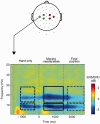Beta oscillations reveal ethnicity ingroup bias in sensorimotor resonance to pain of others
- PMID: 25344947
- PMCID: PMC4483561
- DOI: 10.1093/scan/nsu139
Beta oscillations reveal ethnicity ingroup bias in sensorimotor resonance to pain of others
Abstract
People evaluate members of their own social group more favorably and empathize more strongly with their ingroup members. Using electroencephalography (EEG), we explored whether resonant responses of sensorimotor cortex to the pain of others are modulated by the ethnicity of these others. White participants watched video clips of ethnic ingroup and outgroup hands, being either penetrated by a needle syringe or touched by a cotton swab, while EEG was recorded. Time-frequency analysis was applied to Laplacian-transformed signals from the sensors overlying sensorimotor cortex in order to assess event-related desynchronization and synchronization (ERD/ERS) of sensorimotor mu (7-12 Hz) and beta (13-30 Hz) rhythms. When watching needle injections, beta ERD was significantly stronger for ingroup compared with outgroup hands. This ethnicity bias was restricted to painful actions, as beta ERD for ingroup and outgroup hands neither differed when observing no-pain videos, nor during presentation of the hands without any treatment. Such vicarious sensorimotor activation could play a role in social interaction by enhancing the understanding of the feelings and reactions of others and hence facilitating behavioral coordination among group members.
Keywords: empathy; ingroup favoritism; mirror neurons; mu rhythm; racial bias.
© The Author (2014). Published by Oxford University Press. For Permissions, please email: journals.permissions@oup.com.
Figures



Similar articles
-
Increasing self-other bodily overlap increases sensorimotor resonance to others' pain.Cogn Affect Behav Neurosci. 2020 Feb;20(1):19-33. doi: 10.3758/s13415-019-00724-0. Cogn Affect Behav Neurosci. 2020. PMID: 31190136 Free PMC article.
-
Increasing self-other similarity modulates ethnic bias in sensorimotor resonance to others' pain.Soc Cogn Affect Neurosci. 2022 Jul 2;17(7):673-682. doi: 10.1093/scan/nsab113. Soc Cogn Affect Neurosci. 2022. PMID: 34669949 Free PMC article.
-
Perspective taking reduces group biases in sensorimotor resonance.Cortex. 2020 Oct;131:42-53. doi: 10.1016/j.cortex.2020.04.037. Epub 2020 Jul 15. Cortex. 2020. PMID: 32801074
-
Cortical EEG alpha rhythms reflect task-specific somatosensory and motor interactions in humans.Clin Neurophysiol. 2014 Oct;125(10):1936-45. doi: 10.1016/j.clinph.2014.04.021. Epub 2014 May 24. Clin Neurophysiol. 2014. PMID: 24929901 Review.
-
ERD/ERS patterns reflecting sensorimotor activation and deactivation.Prog Brain Res. 2006;159:211-22. doi: 10.1016/S0079-6123(06)59014-4. Prog Brain Res. 2006. PMID: 17071233 Review.
Cited by
-
The Modulation of Mimicry by Ethnic Group-Membership and Emotional Expressions.PLoS One. 2016 Aug 24;11(8):e0161064. doi: 10.1371/journal.pone.0161064. eCollection 2016. PLoS One. 2016. PMID: 27557135 Free PMC article.
-
Smell and 3D Haptic Representation: A Common Pathway to Understand Brain Dynamics in a Cross-Modal Task. A Pilot OERP and fNIRS Study.Front Behav Neurosci. 2019 Sep 26;13:226. doi: 10.3389/fnbeh.2019.00226. eCollection 2019. Front Behav Neurosci. 2019. PMID: 31616263 Free PMC article.
-
Maturation of Pain Empathy from Child to Adult Shifts from Single to Multiple Neural Rhythms to Support Interoceptive Representations.Sci Rep. 2018 Jan 29;8(1):1810. doi: 10.1038/s41598-018-19810-3. Sci Rep. 2018. PMID: 29379042 Free PMC article.
-
Taking an embodied avatar's perspective modulates the temporal dynamics of vicarious pain and pleasure: a virtual reality and EEG study.Soc Cogn Affect Neurosci. 2025 May 12;20(1):nsaf035. doi: 10.1093/scan/nsaf035. Soc Cogn Affect Neurosci. 2025. PMID: 40279172 Free PMC article.
-
The interaction between felt touch and tactile consequences of observed actions: an action-based somatosensory congruency paradigm.Soc Cogn Affect Neurosci. 2016 Jul;11(7):1162-72. doi: 10.1093/scan/nsv081. Epub 2015 Jul 7. Soc Cogn Affect Neurosci. 2016. PMID: 26152577 Free PMC article.
References
-
- AAPA. (1996). AAPA statement on biological aspects of race. American Journal of Physical Anthropology, 101(4), 569–70.
-
- Allport GW. The Nature of Prejudice. Reading, MA.: Addison-Wesley; 1954.
-
- Avenanti A, Bueti D, Galati G, Aglioti SM. Transcranial magnetic stimulation highlights the sensorimotor side of empathy for pain. Nature Neuroscience. 2005;8(7):955–60. - PubMed
Publication types
MeSH terms
LinkOut - more resources
Full Text Sources
Other Literature Sources
Medical
Research Materials

